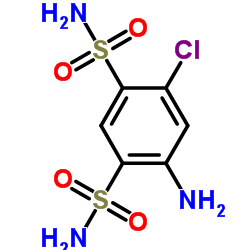Validated micellar electrokinetic capillary chromatography method for quality control of the drug substances hydrochlorothiazide and chlorothiazide.
B R Thomas, X G Fang, X Chen, R J Tyrrell, S Ghodbane
Index: J. Chromatogr. B, Biomed. Appl. 657(2) , 383-94, (1994)
Full Text: HTML
Abstract
A stability-indicating, quality control analysis method was developed and validated for the diuretic drug substances hydrochlorothiazide (HCTZ) and chlorothiazide (CTZ). Micellar electrokinetic capillary chromatography employing the anionic detergent sodium dodecyl sulfate at 30 mM in 20 mM sodium borate buffer pH 9.5 was utilized to separate and quantify the active drug substance HCTZ from CTZ and the common impurity, 4-amino-6-chloro-1,3-benzenedisulfonamide (DSA). A 100 microns I.D. uncoated fused-silica capillary was necessary to provide the sensitivity, i.e. 1 microgram/ml, for quantification of the DSA impurity. In this study, the linearity, precision, selectivity, accuracy, reproducibility and limit of quantitation for the method were investigated for HCTZ, CTZ and DSA. As the first validation of a drug substance method by capillary electrophoresis in this laboratory, unusual care was taken to insure reliability and ruggedness with multiple instruments, capillaries and analysts. Precision and reproducibility in the range of 1% R.S.D. was achieved by controlling subtle injection factors. These included minimizing the time in which the capillary ends were not immersed in buffer or sample during the injection process and minimizing the number of assays for each anode or inlet buffer vial. Stacking induced by differences in ionic strength between sample and capillary buffer was reduced by using a sample buffer concentration similar to that of the capillary buffer. Although stacking accomplished by using lower sample buffer concentrations increased sensitivity, reproducibility was decreased. Achievement of the 1% R.S.D. precision level means that many quality control assays for drugs with good absorbance characteristics can be validated with HPLC reproducibility and CE efficiency. These micellar electrokinetic capillary chromatography methods conform to the USA and European Pharmacopoeial validation guidelines.
Related Compounds
| Structure | Name/CAS No. | Molecular Formula | Articles |
|---|---|---|---|
 |
4-Amino-6-chlorobenzene-1,3-disulfonamide
CAS:121-30-2 |
C6H8ClN3O4S2 |
|
Carbonic anhydrase inhibitors: cloning and sulfonamide inhib...
2006-04-15 [Bioorg. Med. Chem. Lett. 16 , 2182-8, (2006)] |
|
Mass spectrometric behavior of thiazide-based diuretics afte...
2002-08-01 [Anal. Chem. 74(15) , 3802-8, (2002)] |
|
Detection of urinary markers for thiazide diuretics after or...
2009-01-01 [J. Chromatogr. A. 1216(12) , 2466-73, (2009)] |
|
Biopharmaceutical studies of thiazide diuretics. III. In viv...
1987-08-01 [Chem. Pharm. Bull. 35(8) , 3516-8, (1987)] |
|
Binding of 2-amino-4-chloro-m-benzenedisulfonamide as a meta...
1990-10-01 [Chem. Pharm. Bull. 38(10) , 2882-3, (1990)] |